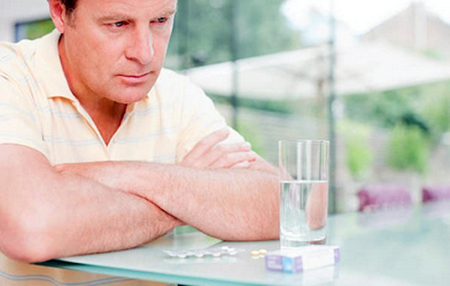Depressive disorders: how is major depressive disorder diagnosed and treated?


Depressive disorders are a group of disorders with a dominant symptom of a subjective feeling of low mood. They can accompany mood (affective) disorders, physical illnesses, adaptation disorders caused by a difficult situation, poisoning and caused by adverse effects of drugs, other mental disorders such as schizoaffective disorders, postpsychotic depression, and mixed depressive-anxiety states, neurasthenia, withdrawal syndromes.
Short information about major depressive disorder
Clinical picture and diagnosis
1. The preliminary diagnosis is facilitated by asking 2 questions:
1) Have you often been feeling depressed and hopeless during the past month?
2) Have you been noticing the disappearance of joy from previously enjoyable activities during the last month?
An answer “yes” to one of these questions has 97% precision and a specificity of 67% for detecting a depressive episode.
2. A doctor should start diagnosing depression by assessing the risk of suicide.
3. Differential diagnosis should be carried out between the following types of the disorder:

1) Depressive episode;
2) Recurrent depression;
3) Bipolar depression;
4) Depressive type of schizoaffective disorder;
5) Post-schizophrenic depression;
6) Depressive type of adaptation disorders (psychogenic depression);
7) Dysthymia (chronic depression);
8) Cyclothymia (alteration of depression with hypomania);
9) Organic mood disorders in somatic or neurological diseases.
Diagnostic criteria for the major depressive disorder episode
The disease is diagnosed in the presence, from a definite and possible to determine time, almost daily and during most of the day, simultaneously for more than two weeks, five of the below- listed manifestations, with at least one of the first two (main ones):

1) Depressed mood;
2) A pronounced loss of interest in almost all types of activity and/or the feeling of pleasure associated with them;
3) Enhanced or diminished appetite, or a significant weight loss (not related to diet) or weight gain (e.g. 5% per month);
4) Insomnia or excessive sleepiness;
5) Excitability or psychomotor retardation;
6) Feeling tired or losing energy;
7) Feelings of inadequacy or unjustified feelings of guilt;
8) A decrease in the productivity of thinking, difficulty focusing or making a decision;
9) Repetitive thoughts about death (not only the fear of death);
10) Recurring suicidal thoughts, suicidal attempts.
A depressive episode is the most frequently diagnosed type of depression. It is present with recurrent depression and bipolar disorder, in which it’s alternated with episodes of mania or hypomania (less severe mania). Correct diagnosis is essential for successful therapy. Besides determining the type of depression, it is crucial to conduct a survey to identify neurotic disorders, which very often accompany them.
Diagnostic criteria for the depressive type of adaptation disorders (simplified)
1. Dominated: feeling down, tearfulness, hopelessness.
2. Symptoms:

1) Occur in response to stress, up to 3 months from his appearance;
2) Significantly exceed the expected stress response;
3) Significantly reduce social or professional functioning;
4) After the cessation of stress, they are retained for more than half a year.
Adaptive disorders are different from a depressive episode by a clear connection between the current mood and an existing problem. If the patient's attention is diverted from the source of the difficulty, they can develop their interests, while experiencing pleasure.
Diagnostic criteria for persistent depressive disorder (dysthymia) (simplified)
1. Depressive mood persists for most of the day and for the predominant number of days for more than two years.
2. At least two of the main symptoms must be present: enhanced or diminished appetite; insomnia or excessive sleepiness; feeling tired or lack of energy; low self-esteem; difficulty in decision making and focusing; feeling of hopelessness.
3. Symptoms last for two years did not disappear for more than two months.
The necessary condition for making a diagnosis is the exclusion of the somatic, i.e. physical, cause of the symptoms, for instance, a chronic disease that causes severe physical discomfort, and their direct connection with major depression.
Diagnostic criteria for cyclothymia (simplified)
Symptoms as in chronic depression, but they are alternated with hypomania (mild mania) every few days.
Criteria for the diagnosis of depressive disorder in somatic (physical) diseases

1. In the clinical picture clearly and persistently depressed mood or significantly reduced interest and pleasure in almost all areas of activity.
2. There is evidence that these symptoms have a direct connection with a particular somatic condition.
Depressive symptoms in other mental disorders
1. Postpsychotic depression after an episode of schizophrenia.
2. A depressive type of schizoaffective disorder - the manifestation of symptoms of both conditions.
Therapy of depressive disorders
1. Remember that depression is not a common blues or a sign of weakness of will or character. You cannot get rid of it or "pull yourself together" - you need to apply the treatment.
2. Listen carefully and with understanding to the patient, do not neglect their complaints. Take very seriously the patient's statements indicating suicidal tendencies and carefully assess this risk.
3. Encourage the patient to engage in activities they previously enjoyed. Do not show displeasure if they did not follow this recommendation, as it means that these actions were probably too difficult for the patient at the moment.
Drug treatment

1. The main role in the therapy of depression is played by pharmacotherapy, the effects of which appear no earlier than 2 weeks later from the start of the drug use. The decision about the ineffectiveness of the drug and about changing the treatment should be made only when it was not possible to achieve an antidepressant effect within 6 weeks.
2. The first or the next untreated episode of depression - leave the choice of a specific antidepressant medication to your future doctor.
3. Relapse of depression in previously treated patient - use the drug that was effective in the previous episode.
4. For mild to moderate depression, the new generation of drugs, escitalopram, mirtazapine, milnacipran, Paroxetine, and sertraline are most effective. When choosing the medication, a doctor must take into account the risk of adverse reactions and interactions with other medications. In severe depression, tricyclic antidepressants are slightly more effective. For depression with psychotic symptoms, antipsychotic medications are also used.
5. Symptoms of anxiety require urgent relief with anxiolytic drugs. Most antidepressants have anxiolytic effects, but the effect occurs within a few weeks of their use.
6. Pharmacotherapy for a depressive episode should continue for more than half a year after the disappearance of symptoms. If 3 episodes occur within 5 years, long-term therapy is recommended.
7. In the case of adaptation disorders, treatment is indicated until the cause disappears or the patient adapts to a difficult situation.
8. Pharmacotherapy of depression in somatic diseases is controversial. According to one view, the therapy of the underlying disease is of fundamental importance, and the therapy of depression depends on the current mental state - after the disappearance of depression, antidepressants are discontinued. According to other professionals, the somatic disease should be considered only the causative factor, and depression should be treated according to the algorithm of actions for this type of depression.
9. In dysthymia, pharmacotherapy is recommended for ≥2–3 years.
10. There are no generally accepted recommendations for cyclothymia. Normotimics are used (mainly derivatives of valproic acid).
11. For all types of depression, the combination of medication therapy with counseling is most favorable. For moderate, severe, and psychotic depression, drug therapy is obligatory. In psychotic depression, the psychotherapeutic effect is auxiliary.
12. Neuronal serotonin reuptake inhibitors and other antidepressant drugs with serotonergic effects can cause serotonin syndrome. Symptoms: changes in mental state (impaired consciousness, hypomania), psychomotor agitation, myoclonus, increased reflexes, fever, profuse sweat, chills, tremors, coordination disorders, muscle rigidity.
Diagnostic criteria:

1) The use or increase in the dose of a drug with a serotonergic effect;
2) Ascertaining ≥3 of the above symptoms;
3) Exclusion of other causes (poisoning, withdrawal symptoms, metabolic disorders);
4) Exclusion of data on the use of antipsychotics that can cause neuroleptic malignant syndrome.
Algorithm of actions: drug withdrawal usually leads to the disappearance of symptoms of the syndrome within 24 hours. In most cases, the course is mild. Monitor vital functions and, if necessary, apply the symptomatic treatment: including body cooling, benzodiazepines to reduce agitation and muscle tension, mechanical ventilation in case of respiratory failure.
13. Stop antidepressant medications gradually (slowly). Discontinuation of antidepressants at once often causes a withdrawal syndrome, which consists of the following symptoms: dizziness, headache, paresthesia, feeling of "electric current", decreased mood, crying attacks or euphoric mood, anxiety, irritation, mental stress, inability to concentrate, insomnia, nightmares, nausea, vomiting, diarrhea, anorexia, spasms muscle groups (dystonia), muscle tremors, muscle pain, weakness, flu-like symptoms, profuse sweating.
Post by: John De Vries, clinical pshychiatrist, Amsterdam, Netherlands
(Updated at Apr 14 / 2024)
Paxil articles:
Some of the trademarks used in this Web Site appear for identification purposes only.
All orders are reviewed by a licensed physician and pharmacist before being dispensed and shipped.
The statements contained herein are not intended to diagnose, treat, cure or prevent disease. The statements are for informational purposes only and is it not meant to replace the services or recommendations of a physician or qualified health care practitioner. If you have questions about the drugs you are taking, check with your doctor, nurse, or pharmacist.